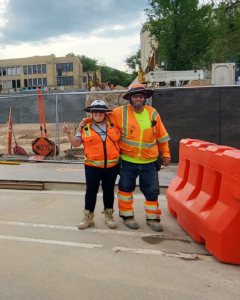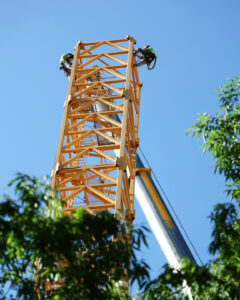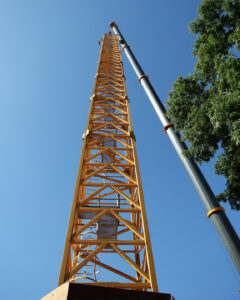As the shrinking Great Salt Lake exposes an ever-growing area of its lakebed, wind-blown dust becomes more dangerous for those living in Utah’s most populous region. It also makes the snowpack dirty, which threatens the state’s most precious resource—water.
“You might see 17 days and think it’s no big deal, but our current snowmelt models don’t account for dust,” said McKenzie Skiles, assistant professor of geography at the U and senior author of a new study in which researchers analyzed the impact of dust on Utah snow during the 2022 season. They found that 2022 had the most dust deposition events and the highest snowpack dust concentrations of any year since observations began in 2009on the paper. “So, the snow is melting, water is coming out earlier and faster than we expect it to, and we’re not prepared to use it in the most efficient way. The landscape is also not expecting the water earlier, so it impacts watershed functionality as well as water availability downstream.”
The study published on June 15, 2023, in the journal Environmental Research Letters.
In 2018 Skiles authored a study that found that a single dust event accelerated snowmelt in the Wasatch by one week. That paper identified the Great Salt Lake as a relatively new dust source due to historically low water levels. Subsequent years of prolonged drought, increased evaporation and sustained agriculture and domestic water consumption drove the Great Salt Lake to record lows in 2021 and 2022 and exposed even more dry lakebed.
“Anecdotally, we kept saying, ‘This is crazy—this is the dirtiest snow in the Wasatch I’ve seen since I started making observations,’” said Skiles. “Ultimately, after we analyzed everything, it was the dirtiest year.”
You don’t need a weatherman to know which way the dust blows …

Derek Mallia
… you need co-author of the study Derek Mallia, a research assistant professor in the Department of Atmospheric Sciences at the U. Strong winds can loft dust into the atmosphere and degrade air quality, which can trigger yellow or red air pollution warnings. Dust-on-snow deposition requires a specific set of factors; nearby dust sources, relatively dry conditions and winds that are strong enough to loft dust into the atmosphere. Mallia developed a dust transport model that can pinpoint where the dust on snow originated by synthesizing meteorological and soil data. For every dust event, Mallia ran his model to identify dust sources that were responsible for accelerating snow melt in the Wasatch Mountains.
“We were expecting large areas like the Great Salt Lake Desert to be a major source of dust, but we were somewhat surprised that we observed such large contributions of dust coming from the Great Salt Lake, and especially Farmington Bay. While the lake’s dust sources are much smaller than the West Desert in terms of area, the exposed dry lakebeds are much closer to the Wasatch Mountains,” said Mallia. “These results suggest that the Great Salt Lake is an important factor when it comes to accelerating snow melt across the Wasatch Front and will become a bigger player if it continues to shrink.”
Read the full article by Lisa Potter in @TheU.
 Bowen is a Professor of Geology and Geophysics and Director of the
Bowen is a Professor of Geology and Geophysics and Director of the 


 Dr. Ofer Rog’s research focuses on the complex regulation of chromosomes during meiosis. Dr. Rog and his assembled team of top-notch researchers have developed new methods, used innovative approaches, and carried out meticulous studies that are now revealing key elements of this complex process. The work conducted by him and his research group has provided stunning insights into the fundamental cellular processes explaining the origin and maintenance of different sexes, including our own. As Director Frederick Adler states, “Dr. Rog is also an extraordinary communicator with a dedication to helping colleagues and students find new ways to communicate.”
Dr. Ofer Rog’s research focuses on the complex regulation of chromosomes during meiosis. Dr. Rog and his assembled team of top-notch researchers have developed new methods, used innovative approaches, and carried out meticulous studies that are now revealing key elements of this complex process. The work conducted by him and his research group has provided stunning insights into the fundamental cellular processes explaining the origin and maintenance of different sexes, including our own. As Director Frederick Adler states, “Dr. Rog is also an extraordinary communicator with a dedication to helping colleagues and students find new ways to communicate.”

 There was a lot to salute March 18th when the Department of Atmospheric Sciences met for its 75th anniversary celebration. The event took place at the Bill & Pat Child Family Community Hall of the University of Utah's Eccles School of Business. Atmospherically, it could not have been better: a clear night with a dramatic sun setting, a few wispy clouds that thickened over the Great Salt Lake and delicately hedged a river of blood-red light that dropped to the lakebed. From the outdoor patio there was a 180 degree view of the valley from the pencil drawn profile of the Oquirrh range west to the frenetic electric lights of University Health campus to the east; from the jeweled-top Capitol Building to the north to a pristine-looking valley south, ending at Traverse Mountain above Draper and "point of the mountain."
There was a lot to salute March 18th when the Department of Atmospheric Sciences met for its 75th anniversary celebration. The event took place at the Bill & Pat Child Family Community Hall of the University of Utah's Eccles School of Business. Atmospherically, it could not have been better: a clear night with a dramatic sun setting, a few wispy clouds that thickened over the Great Salt Lake and delicately hedged a river of blood-red light that dropped to the lakebed. From the outdoor patio there was a 180 degree view of the valley from the pencil drawn profile of the Oquirrh range west to the frenetic electric lights of University Health campus to the east; from the jeweled-top Capitol Building to the north to a pristine-looking valley south, ending at Traverse Mountain above Draper and "point of the mountain." Inside was even more spectacular as about 150 participants gathered for a sit-down dinner and a program that featured live music and generations of ATMOS faculty, staff and alumni. Research and lab posters graced the expansive lobby and a digital photo booth featured the U's mascot Swoop who cajoled and arm wrestled nearly everyone into getting photos with him.
Inside was even more spectacular as about 150 participants gathered for a sit-down dinner and a program that featured live music and generations of ATMOS faculty, staff and alumni. Research and lab posters graced the expansive lobby and a digital photo booth featured the U's mascot Swoop who cajoled and arm wrestled nearly everyone into getting photos with him.


